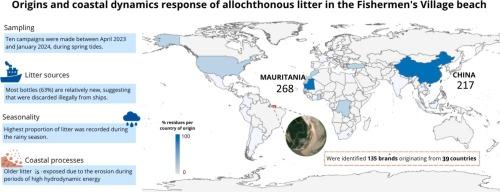Analyzing the origins of allochthonous marine debris in protected area: The Fishermen’s village as a case study
IF 7.1
2区 环境科学与生态学
Q1 ENGINEERING, ENVIRONMENTAL
引用次数: 0
Abstract
The study area is one of the world’s largest contiguous mangrove system and is located within a Protected Area that includes key ecosystems such as dunes, mangroves, restinga, and estuaries. This study hypothesizes that allochthonous marine litter found in the region are primarily the result of illegal dumping from ships, and that the presence of older bottles is influenced by coastal dynamics. To test this hypothesis, ten campaigns were made between April 2023 and January 2024, during spring tides over an area of 75,000 m2. A total of 712 items were collected, 98 % of which were plastic bottles. Of these, 664 had identifiable brands from 41 countries across Africa, the Americas, Asia, and Europe. The presence of allochthonous waste is largely linked to illegal ship discharges, as indicated by the age and state of the bottles. Over 63 % of the collected bottles were new (> 2022), with the primary sources being China and Mauritania. Additionally, the absence of animal bite marks and the low occurrence of epibiontic organisms (only 8 %) further support this conclusion. Monthly analyses showed that during strong winds and low rainfall, debris could become buried in sediment in dune and restinga areas. Conversely, during periods of heavy rainfall or high hydrodynamic energy, erosion exposes older debris, explaining the presence of older bottles, though in smaller quantities. The lack of waste management services on Amazonian beaches within protected areas exacerbates debris accumulation, posing significant environmental challenges and negatively impacting the quality of life of traditional communities.

保护区外来海洋垃圾来源分析:以渔村为例
该研究区是世界上最大的连续红树林系统之一,位于一个保护区内,包括沙丘、红树林、restinga和河口等关键生态系统。这项研究假设,在该地区发现的外来海洋垃圾主要是船只非法倾倒的结果,而旧瓶子的存在受到沿海动态的影响。为了验证这一假设,在2023年4月至2024年1月期间,在75,000平方米的春潮期间进行了10次战役。总共收集了712件物品,其中98%是塑料瓶。其中,664家拥有来自非洲、美洲、亚洲和欧洲41个国家的知名品牌。从瓶子的年代和状态可以看出,外来废物的存在很大程度上与非法船舶排放有关。超过63%的收集瓶是新的(> 2022),主要来源是中国和毛里塔尼亚。此外,没有动物咬痕和低发生率的共生生物(仅8%)进一步支持这一结论。月度分析表明,在强风和低降雨量期间,碎片可能被埋在沙丘和休息区域的沉积物中。相反,在强降雨或高流体动力能量期间,侵蚀会暴露出较旧的碎片,这解释了较旧瓶子的存在,尽管数量较少。保护区内亚马逊海滩缺乏废物管理服务,加剧了碎片的堆积,构成重大的环境挑战,并对传统社区的生活质量产生负面影响。
本文章由计算机程序翻译,如有差异,请以英文原文为准。
求助全文
约1分钟内获得全文
求助全文
来源期刊

Waste management
环境科学-工程:环境
CiteScore
15.60
自引率
6.20%
发文量
492
审稿时长
39 days
期刊介绍:
Waste Management is devoted to the presentation and discussion of information on solid wastes,it covers the entire lifecycle of solid. wastes.
Scope:
Addresses solid wastes in both industrialized and economically developing countries
Covers various types of solid wastes, including:
Municipal (e.g., residential, institutional, commercial, light industrial)
Agricultural
Special (e.g., C and D, healthcare, household hazardous wastes, sewage sludge)
 求助内容:
求助内容: 应助结果提醒方式:
应助结果提醒方式:


